Downsize Your Closet
Find out how to downsize your closet effortlessly and seamlessly
Find out how to downsize your closet effortlessly and seamlessly
What is the difference between a Tiny and a Small House? Learn everything you’ll need to know here!
From 1000BCE to 2020. How has Tiny Living made an impact on our housing needs through the years?
What is sustainability? How does it affect me? What does it have to do with tiny living?
How tiny offices are changing our perspectives on the working environment
What is Minimalism & what does it mean for you?
When downsizing, looking at your “why” is essential. Why is it important to you? What is the purpose of downsizing? No matter if it’s money, a desired lifestyle, family, or something more, the bigger your “why” the more drive you’ll have to get rid of excess and live in your downsized space. – Tiny House Community
While deciding what to keep when downsizing can be extremely challenging, it’s helpful to separate the items you need from the items you want. You may have a gorgeous TV stand and large DVD collection, but practical thinking might instead have you wall-mounting your flat-screen and streaming movies instead. Things that previously would’ve been owned by each member of the home, like a closet or other clothing storage, can instead be treated communally and shared by all. For those considering moving to a modular tiny home, many builders offer optional loft areas for storage. – Wolf Industries
As van travel aficionados, we’ve learned a thing or two about living with less over the years. Our shortlist for downsizing success includes a thoroughly organized list of needs versus wants, multi-purpose items (think Swiss Army knives for starters), and the mental realization that you don’t need a lot of material things to be happy. From working on-the-go to being in a small space with our partners for long trips, we’ve gotten better through trial and error. Not to mention, we’ve got storage down to a fine art. Never underestimate the power of under-bed drawers and collapsible furniture! – Voyager Camper Vans
Start by gathering up all the things you think you need in one place. Chances are you’ll fill up the room! Then group similar things – put your clothes together, cookware, tools, equipment, etc. Now you can start reducing in a very visual way seeing your piles get smaller. Clear out any duplicates or multiples. Consider getting rid of any “single-use” item like a tea kettle. A cooking pot can do double duty by heating water and cooking. You can also evaluate each item in terms of how often you’d use it in a typical week or month. – Vanlife Outfitters
Downsizing is difficult, but once you have freed yourself of your nonessential ‘stuff’, you will find you have so much more freedom. A van is a tiny home on wheels, but if designed carefully, affords you the opportunity to be thoughtful about every inch. We are big fans of clothes cubes and IKEA style storage bins to throw into cabinets. We love the clever use of wall and ceilings space – we have fishing rod holders on the ceiling of one of our vans and hooks strategically placed all over. It’s tough in the beginning but as soon as you get a system in place, it’s second nature. – Aspen Custom Vans
We are firm believers in Pareto’s Principle (the 80/20 rule). We use 20% of our belongings 80% of the time and vice versa. Moving into an alternative living space (like a van) requires an honest inventory of how often you use the majority of your belongings. Many people, that downsize and simplify, find that they are much happier, more focused, and balanced with fewer belongings.
To anyone considering moving into a van – get rid of almost everything you haven’t touched in the last 60 days. In most cases, you can live without it. Believe it or not, you can live without the toaster oven, blender, and panini maker (all of which typically get very minimal, to begin with). – Vancraft
Living in a camper van is the extreme end of tiny home living, therefore you should always ensure each item you own is something you’ll use regularly and won’t easily break – emphasize quality, not quantity on every item you choose to keep. The camper van community loves to share their unique ideas so use the people to your advantage! Reach out, ask questions, and offer to share your own ideas as the best advice comes from someone who is currently living successfully small. – Boho Camper Vans
Here are a few tips: Think small. You will find a smaller version of everything you ever owned: plates, utensils, cups, blankets, etc.
Think collapsible. Many outdoor brands are doing the work for you already: collapsible containers, sinks, foldable tools, compact ovens, etc. They’re usually fun to use as well!
Think optimized. When you think you’re done organizing, think again. Maybe you can fold your t-shirts more effectively, allowing you to have one more in your cabinets. Optimize. Optimize. Optimize. – Vanlife Customs
I always recommend finding a permanent home for everything. Use drawer dividers, spacers and packing cubes. It keeps everything nice and tidy. Keep a laundry bag to store dirty laundry away from your clean items. Have a dedicated space that holds your cleaning supplies including a broom! Keeping your new tiny home tidy is one of the most important pieces of advice! It’ll feel bigger and you’ll be happy to go to bed at night knowing your new home is clean. It also makes finding items and making food a lot more pleasant. – Roamerica
When our tiny house customers ask us to build in storage systems, I always encourage them to begin living in the space before permanently committing to the location of their storage. After you begin using your new space, you get a better feel for which areas can be used for short-term storage and long-term storage (and maybe even which items you no longer need). Once you’ve determined that, you may decide to have storage built-in, or often you can find great storage solutions at IKEA at a fraction of the cost of built-ins. – Carriage Houses NW
Organization and cleanliness are key, especially in a tiny home. When we first downsized, one of our biggest frustrations was tripping over muddy hiking shoes in the morning. Having a dedicated space for wet or smelly items made all the difference. Packing these items in an exterior compartment or a well-ventilated area will keep your home smelling fresh. – Parked in Paradise
Get creative! When one goes tiny there is very little room for excess. In the case of a houseboat, van, and some tiny homes, you will encounter a much different bathroom experience. Whether it is water limitations because of tank capacity or just general space in a bathroom, B&B has a lifehack for this. Take advantage of facilities in your surrounding areas. A gym membership will promote a healthy active lifestyle and give you access to a social atmosphere, showers, towels, hygiene products, and a general mental stimulus to occupy a portion of your day. Getting comfortable using a gym or clubs’ facilities could make the transition from a multiple bathroom situation down to a tight one bathroom household much easier. The money saved from the downsizing can usually more than cover your membership to these facilities. – B&B Tiny Houses
Choose items that can be used for multiple purposes when deciding what to take with you. For example, when we are building a van, we use a couch that turns into a bed and also has storage available below. Why not think that way when you pack? – Sportsmobile
With downsizing, there are two major things that have helped me in my minimalism journey. The first is to keep and pursue belongings that are dual purpose. If something can’t serve me in more than 1 way, I try to donate it, or simply just don’t purchase new items that don’t have a dual purpose. The second most important thing is to consolidate my belongings into 1 quality item. For example, when I moved into a van I had 5 pairs of black leggings – some were old, some had holes in the knees, etc. I donated all 5 and invested in a single high-quality pair and that new pair has now lasted me for multiple years. I apply this same principle to many items: drinking cups, shoes, backpacks, hiking gear, and more. It’s really made a difference! For more inspiration, you can also check out our Instagram here. – So We Bought A Van
Since Outside Van is a fully custom van conversion company, we encourage vanlifers to be unique when designing their one-off vehicles. Since a van has limited space, focus on functional systems like power, solar, heat, and water. Just because a van looks good in photos doesn’t mean it’s a high-performing, functional vehicle for full-time living. And you might reconsider needing a toilet. – Outside Van
When preparing to move into a small space don’t limit your planning to where you will store things you want to keep, but also consider how you will manage your waste. Trash, recycling, and food waste can build up faster than you expect. Your beautifully designed space can quickly become a nightmare when three-day-old cans of tuna are left overflowing from your trash. Consider what waste a product will create before you buy it. – Vanvaya
We all have boxes of records, stacks of magazines and catalogs, unwanted piles of old bills, envelopes, lists, notebooks, etc. Every cubic inch of a tiny home is loaded with intention and care for how the space looks and feels; a couple of boxes worth of this stuff could be lifestyle defining. It might mean you couldn’t have a chair for a friend when she visits, some sports equipment you’ve been wanting, or space for plants and animal friends. Scan it, upload it onto a computer and throw it onto a hard drive. Instead of books, music CDs, and Movies on DVD, transition to eBooks, Netflix and Spotify to declutter your collections.
Additionally, you can always consider moving somewhere warm so that your clothes are smaller, and you need less of them. – TruForm Tiny Homes
In an era when modern life is fast-paced, more demanding and stressful, slowing down and savoring life can be hard. Costs of living are increasing all over the world, from Hong Kong to San Diego, so communities of ambient folk living on residential boats, camper-vans, trailers and static homes are gaining popularity as people escape the urban squash. Downsizing will mean that personal space is at a premium. While it can be a hugely bonding experience, you will be asking your loved ones to kindly move so you can pass every time you walk from the kitchen to the bedroom. It’s impossible to be materialistic, as there simply isn’t room to store anything surplus to absolute requirement. Cooking becomes simplified, clothing whittled down to necessities and trinkets a thing of the past. – Rightboat
One of the most valuable things we can suggest when preparing to move into a smaller space is to make sure you are on the same page with your partner/housemates. Though you might think it’s not a big deal to throw away that box of high school trophies your wife has been lugging around for four years, it might be something they don’t want to toss. Make sure you do a visual assessment of your current space and then figure out a plan to downsize together. Perhaps there’s a designated area where you can put things you want to toss that everyone can look over before they actually end up in the dumpster or at Goodwill. – Authentic Asheville
Choosing to live a smaller, simpler life with your partner is often a challenging yet incredibly rewarding experience. My advice: don’t expect a tiny house to fix anything in your relationship; what it will likely do instead is to intensify everything. To be successful, it takes an increased focus on good, honest communication and kindness, moment to moment, to make sure each of your needs is met. This means designing your house (or lifestyle) to be sure both of you have the physical space (and time to yourselves) needed to thrive. If done with care, a shift to a smaller (even tiny house) lifestyle can bring you both more joy, intimacy and freedom. – The Tiny Project
Originally published on Redfin
A thief would have to be pretty determined to steal a whole house. A tiny house on wheels is a highly visible item and most are custom-built, making it an easily recognizable theft. It’s not the type of thing a thief can slip away with in the night and sell on the internet, never to be seen again. There are only so many places on the internet to sell one, all of which can be monitored to see when the house comes up for sale. Additionally, to transport a tiny house, one can take it on certain roads, but it has to have a license plate, and any tiny house owner can attest that tiny houses on the road generate a lot of buzz.
However, two recent thefts of tiny houses have popped up in the news, reminding us that while rare, it can happen. On that note, it’s important to find a way to secure one’s tiny house and prevent or at least deter thieves from breaking in or stealing it.
The best course of action to ensure your house’s security is having multiple theft deterrents. The idea of theft deterrence is realizing you can’t do everything possible to ensure your house will never get broken into or stolen altogether, but there are many small things you can do to discourage criminal activity. Many thefts are crimes of opportunity: if you make it a difficult and time-consuming for a thief to quietly drive away with your house in tow, they are more likely to pass your tiny house up.
Just a note: we’ve included links to certain products in this article. We aren’t being compensated for posting any of these products and we don’t necessarily recommend or guarantee these exact products: the links are here so you can get a feel for what they are and how they work.
 Trailer Hitch Lock:
Trailer Hitch Lock:A hitch lock is an easy, quick theft detterent. It can be cut off, but not without spending some time and creating some noise. This will at least slow down a potential house thief, and some have the added benefit of preventing runaway trailers.
There are numerous types of trailer hitch locks, ranging in price from about $17-$45. Here’s a list of reviewed trailer hitch locks from thetoppro.com.
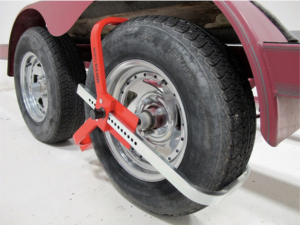 Wheel Lock:
Wheel Lock:These work in many different ways, but the one pictured here covers the wheel, rendering it immobile. You can also purchase locks for the lug nuts themselves. Here’s a list of wheel locks from etrailer.com: they range in price from under $10 to $180.
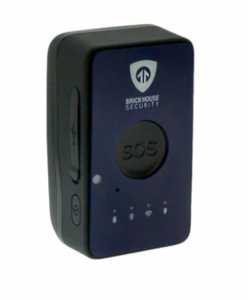 God forbid someone actually gets away with your tiny house, it would be easy to track if you have one of these in or on your tiny house. Hundreds of discreet GPS trackers are on the internet, and many are inexpensive enough to make the purchase worth the peace of mind you’d get from having one. The tracker pictured here, from Brickhouse Security (here are their best GPS trackers), is less than 2″ x 3″, so you can place it inconspicuously so a thief doesn’t know it’s there. You can track its location on your phone or computer.
God forbid someone actually gets away with your tiny house, it would be easy to track if you have one of these in or on your tiny house. Hundreds of discreet GPS trackers are on the internet, and many are inexpensive enough to make the purchase worth the peace of mind you’d get from having one. The tracker pictured here, from Brickhouse Security (here are their best GPS trackers), is less than 2″ x 3″, so you can place it inconspicuously so a thief doesn’t know it’s there. You can track its location on your phone or computer.
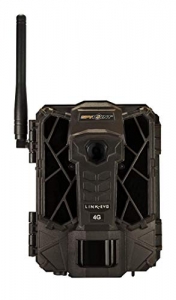
As the economy forces package thieves to become bolder and bolder, the market for home security has exploded, and security cameras are getting cheaper every year. Even if your security camera doesn’t prevent the most determined thief, it is certainly a theft deterrent. Some security cameras use motion detection to start recording a ten-second video; others record all the time.
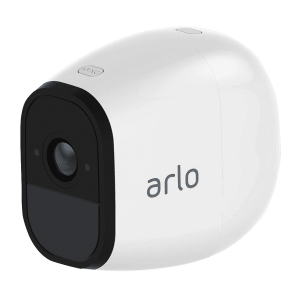
Security cameras that store the images and/or video inside them are only helpful after you recover the camera itself. A smarter choice is either a wifi-connected home security camera like Arlo or Nest, or a trail cam, which operates on cell data (you’ll have to pay monthly). Both a wifi-connected cam (here are PC Mag’s top picks for 2019) or a trail cam (here are Trail Cameras’ Reviews for 2018) allow you to see the images in near-real-time on your phone or computer.
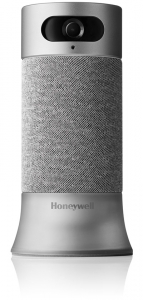 If a security camera isn’t enough, you can have a whole integrated security system in your tiny house, as long as your house gets constant power. Smart home security systems like Honeywell’s allows you to choose a la carte what features you’ll use, such as notifications when windows or doors are opened, motion light activation, facial recognition of those entering your house, and voice control with Amazon Alexa.
If a security camera isn’t enough, you can have a whole integrated security system in your tiny house, as long as your house gets constant power. Smart home security systems like Honeywell’s allows you to choose a la carte what features you’ll use, such as notifications when windows or doors are opened, motion light activation, facial recognition of those entering your house, and voice control with Amazon Alexa.
(Full disclosure– Honeywell’s not paying us to post this, but we did build a tiny house for them integrating their smart home tech, so we’re familiar with their technology and we like their brand).
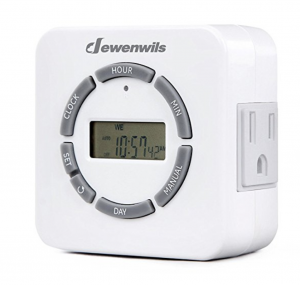
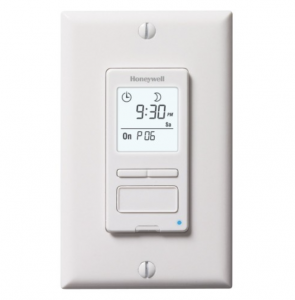
These lights are great for when you’re not at home but want to give the impression that someone is there.
The simplest and cheapest option is a light timer, which can either be plugged into a wall socket (this one’s by Dewenwills, pictured at left) or integrated into the light switch plate (this one’s by Honeywell, pictured at right). It turns a lamp or electric outlet on and off at a specific time or times every day. The mechanical ones make a clicking sound that will drive you nuts in a small space, so we recommend an electronic light timer.

Most people have been familiar with motion sensor lights for decades. Not only can they be a theft deterrent by attracting attention to the house when there’s movement, they can also increase the security of the tiny house dweller when coming home and fumbling for keys in the dark. Here’s The Spruce’s list of best motion sensor lights for different outdoor areas. Some of these contain the sensor within the bulb, so the bulb can be screwed directly into any light socket, which means you won’t have to do any wiring to make them work. Some of the lights on this list run on their own solar power which is nice for when your tiny house isn’t connected to a power system.
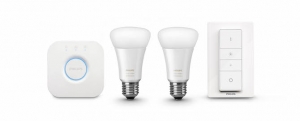
Like timed lights, remote controlled lights help create the illusion that someone’s home, but they’re a bit “smarter” in terms of going on either when they sense motion or when you decide to activate them from afar via your electronic device. Remote-controlled smart lights, for when you’re far away to your wifi-connected tiny house, allow you to turn on a light in your home via an app on your phone. Here are a couple ways to integrate smart lights from Make Use Of, whether your house hasn’t been built yet and you can install these during the building process, or you’d like to install plug-and-play smart lights in your exisiting tiny house. You can also get remote control of the lights in your tiny house by incorporating them into your existing smart home security system.
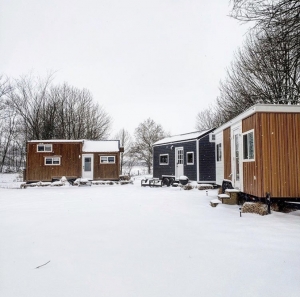 This one’s pretty simple: although not all tiny house owners are parked near neighbors, those who are and have a friendly rapport with them can ask their neighbors to keep an eye on their tiny house. Having possible witnesses close by is a major deterrent to break-ins and thefts.
This one’s pretty simple: although not all tiny house owners are parked near neighbors, those who are and have a friendly rapport with them can ask their neighbors to keep an eye on their tiny house. Having possible witnesses close by is a major deterrent to break-ins and thefts.
(Pictured: The Hoosic Tiny House flanked by two other tiny houses. Photo by Try It Tiny)
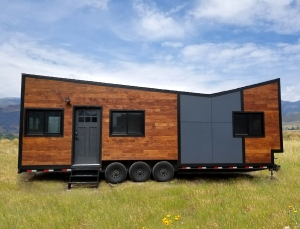 When choosing a location for your tiny house, from a theft deterrent standpoint, consider how easy it is for someone to get away with your tiny house. Anyone who’s ever towed a tiny can attest that tiny houses attract a lot of attention on the road. People peer out of their windows, take photos, post them on the internet. Whether you want to attract attention or not, it’s like being in a single-float parade.
When choosing a location for your tiny house, from a theft deterrent standpoint, consider how easy it is for someone to get away with your tiny house. Anyone who’s ever towed a tiny can attest that tiny houses attract a lot of attention on the road. People peer out of their windows, take photos, post them on the internet. Whether you want to attract attention or not, it’s like being in a single-float parade.
Likewise, if your tiny house is easily recognizable, it’s more easily recovered. An unusual looking tiny house can’t go as far and long without being reported.
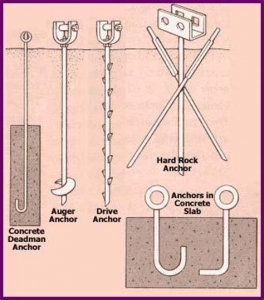 For those who do not travel with their tiny house, tie-downs aren’t just a good idea for theft deterrence. They’re also a great idea to keep the house from rocking or even lifting during a hurricane. Although one can remove the house from the anchors (with varying degrees of difficulty depending on which type of anchor you’re using), this takes time and is another way to deter theft.
For those who do not travel with their tiny house, tie-downs aren’t just a good idea for theft deterrence. They’re also a great idea to keep the house from rocking or even lifting during a hurricane. Although one can remove the house from the anchors (with varying degrees of difficulty depending on which type of anchor you’re using), this takes time and is another way to deter theft.
Additionally, building a porch onto the front of your tiny house not only expands your livable space in nice weather and creates a more welcoming entrance, it makes it more difficult for a thief to quickly steal your tiny house.
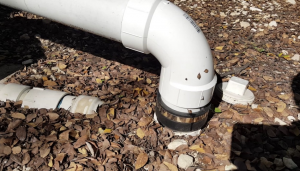 Like anchoring with tie-down straps, it’s not impossible to remove a septic or sewer tie-in, but it takes longer, requires tools and knowledge which means it takes longer to steal someone’s house. Of course, not all tiny houses stay in one location– they are on wheels, after all– but for those that do, this is a great option.
Like anchoring with tie-down straps, it’s not impossible to remove a septic or sewer tie-in, but it takes longer, requires tools and knowledge which means it takes longer to steal someone’s house. Of course, not all tiny houses stay in one location– they are on wheels, after all– but for those that do, this is a great option.
Image from My Camper Home on Youtube
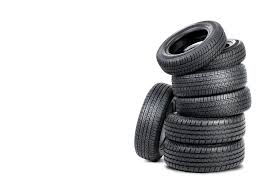 When the tires are removed, a thief can’t just hook up a tiny house to their truck and roll away with it. It takes time and tools to attach four or six tires to the wheels of a trailer: time that exposes a thief to witnesses.
When the tires are removed, a thief can’t just hook up a tiny house to their truck and roll away with it. It takes time and tools to attach four or six tires to the wheels of a trailer: time that exposes a thief to witnesses.
I work in a tiny house. More specifically, a mobile office. Here at B&B, our company has grown faster than our factory has, so now a few of us share the 8 1/2′ x 20′ Brodie Mobile Office for 8 hours a day, 5 days a week. During that time, I’ve learned quite a few things about how to best design a small space for maximum working and living.
Here’s what I’ve learned:
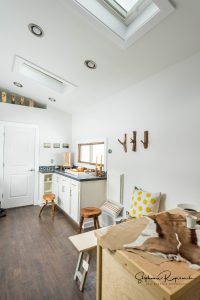 Windows and skylights make a huge difference.
Windows and skylights make a huge difference.Before moving out to the mobile office, I was working inside the factory in a little room we built into the corner of the warehouse. This room had windows to the factory but no windows to the outside. Now that I’m in the mobile office and my desk faces two windows, my quality of life has really improved. The old office, although it was bigger than the mobile office, felt a bit cave-like, and not in the way of grand echoing caverns; it was more like those tiny spaces spelunkers narrated by David Attenborough have to squeeze their bodies into. Anyhow, with its tall ceilings, skylights, and windows all around, the tiny mobile office, although smaller than the old office, feels way more spacious.
Both for air exchange and light, it’s nice to have windows on all sides of you. Opening a window at either side of the house creates a nice breeze. Because you’re surrounded by windows rather than looking at one or two walls with windows, the space feels more expansive and airy than a smaller space.
This goes for any house, not just tiny houses, but it’s something I’ve learned from this particular tiny house so I thought I’d share it here. I can’t stress this enough: choose a floor color that’s not going to show every single piece of dirt, dust, sand, mud, piece of grass, and microscopic pebble. This house was photographed on a day when the snow went up to our knees and we mopped the floor just before the shoot. If we hadn’t, you’d see all kinds of smudges on it.
The absolute best floor for mud-concealment is this grey one with lots of color variation. This house (the Arcadia Tiny House) has been exhibited on rainy, muddy days with hundreds of people (and double that number of boots!) walking through and you couldn’t even tell it was dirty.
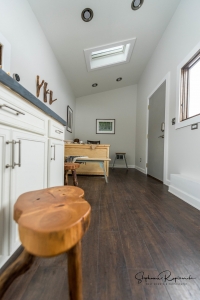
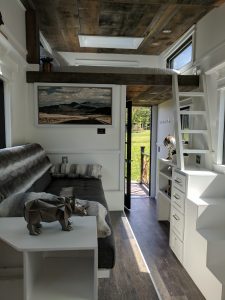
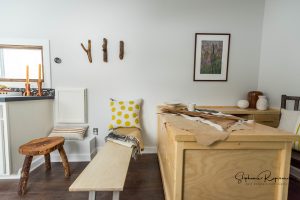 Mobile offices are great for greeting customers outside the work area.
Mobile offices are great for greeting customers outside the work area.Our workshop has six tiny houses being built at a time, with houses, trucks, deliveries, forklifts, et cetera rolling in and out of our factory doors all day. We don’t generally like to invite visitors inside this active work environment simply because it’s too much of a liability. Having the mobile office outside as the face of our company allows us to greet customers in a safe environment, free of sawdust, noise and hazards.
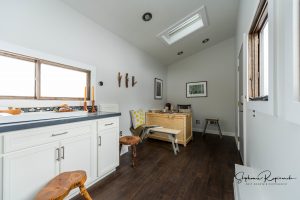 More people can fit in an 8 1/2′ x 20′ space than you think without feeling claustrophobic.
More people can fit in an 8 1/2′ x 20′ space than you think without feeling claustrophobic.We’ve had non-claustrophobic meetings with ten people inside. The level of claustrophobia definitely depends on the amount of stuff inside the house. Since this is an office, not a home, and most of our files are digital, not on paper, we really don’t need that much stuff inside the mobile office. We keep architectural samples, like color chips, siding swatches, and stain samples, but other than that pretty much everything’s digital.
Additionally, the objects that we do have are stored inside the cabinetry so they don’t add to visual clutter.
It’s quiet in the mobile office. Really quiet. It’s a side effect of being well-insulated. So during mealtimes it can be a bit… overwhelming for someone who doesn’t like to hear others chewing. My favorite white noise generator is Celestial White Noise on YouTube. Ten hours of a gentle hum that you tune out after a minute and don’t have to hear every time your coworker shifts in their chair.
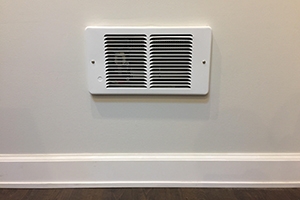
I have hot soup for lunch all the time in the winter. To make sure the mobile office doesn’t then smell like soup for the rest of the day, I always open the restroom door and turn the extractor fan on after eating a hot lunch. It only takes a couple minutes to return the air in the house to freshness.
Certain heating and cooling systems also include air exchange (ours doesn’t)– I’d recommend getting that if possible.
 Tall ceilings and not too much clutter on the walls really make a space feel bigger.
Tall ceilings and not too much clutter on the walls really make a space feel bigger.Perhaps this goes without saying, but I think it’s worth mentioning the tall ceilings inside this tiny mobile office. In order to be road-legal, the tiny house has to be under 13 1/2′ tall so it can fit under bridges, trees and power lines. With the inside floor being just over 2′ off the road, there is still room for a taller-than-usual ceiling inside– and it makes a huge difference!
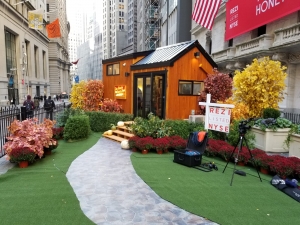
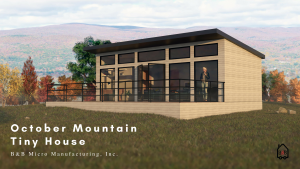
Left: A Tiny House on Wheels- the wheels are obscured by shrubbery. Right: A Modular Home: no wheels, slab foundation (coming soon!)
Tiny houses on wheels are permanently on the chassis. The tires can be removed but the house will always be on the trailer. If you want a tiny house on wheels but don’t plan to travel with it, we can also permanently anchor a tiny house on wheels to the ground, remove its tires, and skirt it. Road-legal limits of 8 1/2′ wide and 13 1/2′ high constrain the size of tiny houses on wheels. We are certified to build tiny houses on wheels by the RVIA, so our tiny houses on wheels are legally considered RVs. Tiny houses on wheels don’t require a building permit, but you’ll need to make sure RVs are allowed in your zone of your town.
Modular homes are constructed in pieces in a factory and then transported to the home site to be assembled and attached to the foundation. They look just like traditional houses– you can’t tell the difference between a modular home from a traditional home just by looking at it– and can be any shape and size as long as each module is small enough to travel from the factory to the build site. After a modular home is built and inspected inside the factory, it is transported to the site and then permanently attached to a foundation (basement, slab, or pin foundation) where it is inspected again. B&B Micro Manufacturing is certified to build Industrialized/Modular Homes by the State of Massachusetts. Modular homes are financed using traditional home financing and there’s no difference in zoning for a modular home versus a traditional site-built home. B&B Modular designs will be released soon.
Both types of homes are built inside our factory in Massachusetts. The advantages of factory-building include a quicker build time (we don’t have to stop working in extreme weather) and a less expensive build, especially when the home is built alongside other homes of the same design.
Learn more about our process or fill out the form below and one of our tiny house experts will reach out to you.
